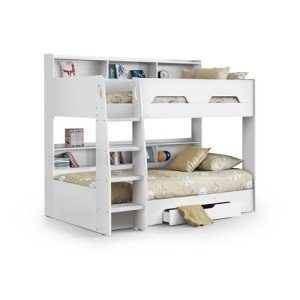Title: The Ultimate Guide to Kids Bunk Beds
Intro
As children grow, so does their requirement for area and storage solutions. bunk for adults are an exceptional method to maximize area while providing a fun and practical sleeping plan for your kids. This thorough guide will check out the different types, advantages, safety factors to consider, and FAQs related to kids bunk beds.
I. Types of Kids Bunk Beds
- Standard Bunk Beds: These are the most common type, including two twin-sized beds stacked on top of each other.
- Futon Bunk Beds: The bottom bunk is replaced with a futon, supplying a sofa and a bed in one piece of furniture.
- Twin-Over-Full Bunk Beds: The bottom bunk is bigger, accommodating a full-sized bed mattress, while the top bunk is a twin.
- L-Shaped Bunk Beds: These consist of two beds put perpendicularly, offering more floor area beneath.
- Loft Bunk Beds: A single bed is positioned on a raised platform, leaving room for a desk, play location, or storage beneath.
II. Advantages of Kids Bunk Beds
- Space-Saving: Bunk beds are perfect for smaller sized bed rooms, releasing up flooring space for other activities and furniture.
- Enjoyable and Exciting: Children frequently delight in the novelty and experience of climbing to their own private sleeping location.
- Cost-Effective: Purchasing one bunk bed is more budget-friendly than buying two separate beds.
- Versatile: Many bunk beds can be separated into 2 different beds as children grow older or when area allows.
- Integrated Storage: Some bunk beds come with built-in storage services, such as drawers, desks, or racks.
III. Security Considerations
- Sturdy Construction: Ensure the bunk bed is made from strong, long lasting materials and has a secure ladder for safe gain access to.
- Correct Spacing: Gaps in between the mattress and the frame ought to be less than 3.5 inches to prevent entrapment.
- Proper Height: Select a bunk bed with an appropriate height for your child, considering their age, size, and ability to climb and down securely.
- Secure Mattresses: Use the proper size bed mattress and protect it to the bed frame to prevent it from shifting throughout sleep.
- Guardrails: Ensure guardrails are set up on both sides of the top bunk and are at least 5 inches higher than the top of the bed mattress.
IV. Frequently asked questions
- What is the ideal age for a child to sleep on the leading bunk?It is normally recommended to wait up until a child is at least six years of ages before permitting them to sleep on the top bunk.
- Can bunk beds be separated into 2 different beds?Yes, some bunk beds can be taken apart and transformed into two separate beds.
- Just how much area is needed between the bottom of the top bunk and the top of the bottom bunk?A minimum of 2 feet 8 inches is advised for head clearance on the bottom bunk.
- Are bunk beds safe for children?When appropriately assembled and utilized, bunk beds are safe for children. Always follow safety guidelines and ensure your child understands the guidelines for using the bunk bed.
V. Conclusion
Kids bunk beds are a practical and enjoyable option for optimizing space and providing a special sleeping experience for your children. By thinking about the different types, benefits, and security considerations, you can make an informed choice when choosing the best bunk bed for your household.

